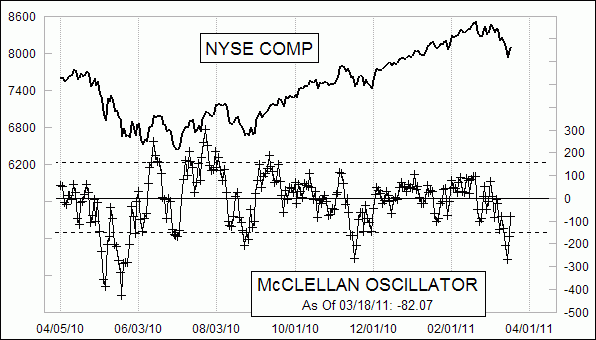Oversold McClellan Oscillator

Free Chart In Focus email
Delivered to you every week
Our chart this week is the same one that we feature every day on our Market Breadth Data page, in the free portion of our web site. This is the original McClellan Oscillator, originated in 1969, and calculated based on the difference between the numbers of advancing and declining issues on the NYSE. You can learn more about its calculation and interpretation here.
Investors' worries over the earthquake, tsunami, and nuclear crisis in Japan led to a 6.8% total selloff in the NYSE Composite Index, and produced a deeply oversold reading of -269.6 in the McClellan Oscillator. Readings below -200 are pretty rare, and in the past year we have only seen it dip down that low or lower on four previous occasions.
What happens in the days and weeks after we see one of these extreme excursions depends on what else is going on. The McClellan Oscillator is a great tool, but it should never be used all by itself, and without an understanding of what else is going on. By itself, a McClellan Oscillator low below -200 says that the market is oversold and due for at least a bounce. But it depends on other factors to determine whether that bounce turns into a resumption of an uptrend, or instead just serves to temporarily relieve the oversold condition.
During the May 2010 Flash Crash, we saw the McClellan Oscillator get down as low as -388. It bounced almost all the way up to the zero line, before falling back down again to an even lower low of -426, which is the all-time low on a raw basis (not adjusting for the larger number of issues). It took a lot more pattern development in the weeks that followed to get the market started on the upward path again. And it did not hurt that the Fed started its second round of quantitative easing (QE2) on Aug. 17, 2010.
The first round of QE had ended on Mar. 24, 2010, a month ahead of the April 23 price top. So the Fed's liquidity was not there during the May 2010 Flash Crash to help smooth out the liquidity problems that month. By contrast, the post-election selloff in November produced a McClellan Oscillator reading of -266 at a time when permanent open market operations (POMOs) were still underway. That turned out to be just a quick dip, and the market got back to trending higher.
Now, we have another McClellan Oscillator reading below -200, at a time when POMOs are still underway. And we are also still in a period of favorable seasonality right now. Both the POMOs and the positive seasonality are scheduled to end in June, and so from that point onward we can adopt a different interpretation of the meaning of an extreme McClellan Oscillator reading.
Tom McClellan
Editor, The McClellan Market Report
Jan 28, 2011
Common Only McClellan Oscillator |
Oct 29, 2010
POMO: The Hot New Timing Tool |
Jun 18, 2010
All Time Record Low McClellan Oscillator |